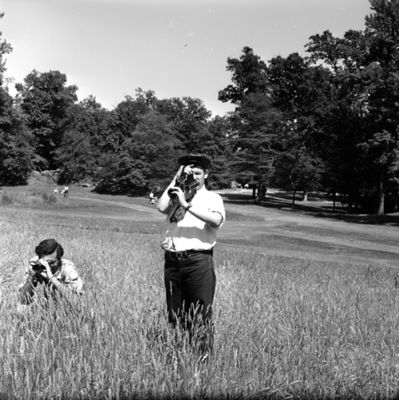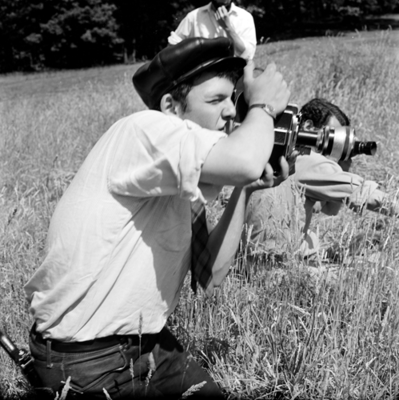Showing posts with label Fred Camper. Show all posts
Showing posts with label Fred Camper. Show all posts
26.8.13
Call & Response
3:57 PM
---
In the 1980s, some of the most ardent, persistent, and perspicacious champions of the American avant-garde - P. Adams Sitney, Fred Camper, Noel Carroll, J. Hoberman - made declarations to the effect that the movement was in a state of profound crisis.* Supposed causes of the predicament were many and varied: skyrocketing costs of 16mm production; cutbacks in government and private foundation funding; a paucity of fresh styles or ideas in the rising generation of filmmakers; a corporately staged obsolescence of key equipment and film stocks; economic and aesthetic challenges posed by video; the negative impact of academic film theory. Debate on the dire state of avant-garde film culminated in 1989 in a large, well-funded, and suitably contentious ''International Experimental Film Congress," held in Toronto, whose extensive screenings, panels, and informal events carried an unmistakably elegiac tone.
A decade later the stream of grim assessments had evaporated, dismissed by some as stodgily alarmist and rebutted by the achievements of a vibrant cadre of younger artists and their return to the sort of vagrant, artisanal, trickle-up energies that had characterized the movement during prior moments of heightened creativity. From a current perspective, there are several possible, not necessarily exclusive, reasons for the perception of "crisis" and its rapid reversal. Established critics and programmers might have been momentarily out of touch with grassroots, geographically dispersed factions at the forefront of change. Or perhaps avant-garde film is in perpetual crisis and pronouncements about its death form part of a self-validating ritual. A third option is that there was in fact a weakening of commitment but, phoenix like, the movement revived itself in response to what, especially, younger makers saw as a cycle of overconsolidation and complacency-rather than slippage-from which they gleaned opportunities for localized intervention. Whatever the case, this intramural profile does not take into account additional factors such as the broader state of visual culture, including mass culture, and various pressures exerted by feminist, queer, and minority political initiative.
*...I participated in the chorus of naysaying by descrying the impact of narrative feature filmmaking on established avant-garde practices...
(Paul Arthur A Line of Sight...)
---
from The Postmodern Moment
---
from Art after Modernism: Rethinking Representation
---
from A Line of Sight...
---
-1989
from A Line of Sight...
---
Let's set the record straight.
We challenge the official History promoted by the International Experimental Film
Congress to be held in Toronto this Spring. The time is long overdue to unwrite the
Institutional Canon of Master Works of the Avant-Garde. It is time to shift focus
from the History of Film to the position of film within the construction of history.
The narratives which take up this new task must respect the complexity of relations
among the many competing and overlapping histories which make up the activity
within the field.
We are concerned by the tone which pervades the announcements for the Congress.
The recognition belatedly accorded to "the founding women of the avant-garde," the
ceremonious embalming of lively, refractory work, the minimal attention given new
work, the organization of screenings along nationalistic lines, and the "open" -- read
"unpaid" -- screenings for those willing to pay $100 for the privilege, all betray a
tokenism blind to any activities outside the officially sanctioned margins. And if our
analytic concerns seem to prejudge the event, they are borne out with desolate clarity
by the record of the Congress organizers in attempting to suppress dissent within
their own community. Their efforts in Toronto against the Funnel Experimental Film
Centre and against feminist film theory speak for themselves.
And while the putatively timeless Internationalism of the Congress should make it all
things to all people, the overwhelming majority of the announced participants consists
of representatives of the 60's Avant-Garde and its decaying power base. Only one or
two younger filmmakers have been made part of the official program, though some of
us will at least be discussed in our absence. Workshops are dominated by
technological values and are lead exclusively by older men. In this context, the organization of screenings along nationalistic lines promises a replay of the results
with which we have become all too familiar over the past decade: a government-
subsidized inventory of products suitable for export. Work is chosen to minimize
linguistic, sexual, and cultural difference, typically to conform to the model of the
"universal language of form" so dear to institutional esperantists.
Difference is
recognized only where it can be recuperated and diluted to a tepid pluralism.
The "open screenings" at best provide an image of damage control. These screenings,
as the de facto venue for new and unrecognized work, have been scheduled mostly for
late in the evening at the end of full days of featured panels, workshops and
screenings. Even without average festival delays, this scheduling usually bodes poorly
for attendance. The priorities of the Congress organizers are clear: those without
established institutional credentials are to be marginalized within the consolidation of
the official margins, to be presented as Film Historical leftovers.
There is a spirit of mind which continues to challenge the hegemony of industry, of
government, of bureaucracy. The revolutionary frame of mind pervading activity in
film in the Teens and Twenties and again in the Fifties and Sixties -- which seemed to
die in the Seventies -- continues to thrive, but only where it has shifted and migrated
according to changing historical conditions. The issues which galvanized the Cinema
Avant-Gardes of earlier decades arose from different conditions than those which
confront us today. An event which promotes itself as of major importance to
Experimental Film and fails to reflect the vitality and breadth, the vulnerability and
urgency of current oppositional practice in the media renders nothing but obeisance to
a moribund officialdom. It risks nothing but its own historical relevance.
The Avant-Garde is dead; long live the avant-garde.
-1989
Signed by 76 film-makers (U.S. and Canada):
Caroline Avery
Peggy Ahwesh
Timothy S. Allen
Craig Baldwin
Susan Banas
Jay Blankenship
Emily Breer
Don Brennan
Barbara Broughel
Edmund Cardoni
Abigail Child
Romy Charlesworth
Tom Chomon
Catherine Clarke
Bill Daniel
Moyra Davie
R. Dickie
Paul Dickinson
Jesse Drew
Barry Ellsworth
Steve Fagin
Bruce Fiene
Mary Filippo
Nina Fonoroff
Su Friedrich
John J. Gallagher
David Gerstein
Joe Gibbons
Annie Goldson
Barbara Hammer
Peter M. Hargrove
Todd Haynes
Eve Heller
Peter Herwitz
Robert Hilferty
Chris Hill
Kent Howie
Jim Hubbard
Barbara Lattanzi
I. Lempert
Lewis Klahr
Mark LaPore
Marck McElhatten
Ross McLaren
Deborah Meehan
Andy Moses
Allen Mukamal
Linda Peckham
John Porter
Yvonne Rainer
Berenice Reynaud
Tom Rhoads
Fabio Roberti
D. Rogers
Ron Rogers
Lynne Sachs
Keith Sanborn
Lincoln Schlensky
Sarah Schulman
M. M. Serra
Esther Shatavsky
Joe Shepard
Jeffrey Skoller
Karl Soehnlein
Philip S. Solomon
Carty Talkington
Christine Tamblyn
Leslile Thornton
Christine Vachon
Luis E. Vera
Susanna Virtamen
Jack Walsh
Dan Walsworth
Andreas Wildfang
Sarah E. Wright
Tom Zummer
Peggy Ahwesh
Timothy S. Allen
Craig Baldwin
Susan Banas
Jay Blankenship
Emily Breer
Don Brennan
Barbara Broughel
Edmund Cardoni
Abigail Child
Romy Charlesworth
Tom Chomon
Catherine Clarke
Bill Daniel
Moyra Davie
R. Dickie
Paul Dickinson
Jesse Drew
Barry Ellsworth
Steve Fagin
Bruce Fiene
Mary Filippo
Nina Fonoroff
Su Friedrich
John J. Gallagher
David Gerstein
Joe Gibbons
Annie Goldson
Barbara Hammer
Peter M. Hargrove
Todd Haynes
Eve Heller
Peter Herwitz
Robert Hilferty
Chris Hill
Kent Howie
Jim Hubbard
Barbara Lattanzi
I. Lempert
Lewis Klahr
Mark LaPore
Marck McElhatten
Ross McLaren
Deborah Meehan
Andy Moses
Allen Mukamal
Linda Peckham
John Porter
Yvonne Rainer
Berenice Reynaud
Tom Rhoads
Fabio Roberti
D. Rogers
Ron Rogers
Lynne Sachs
Keith Sanborn
Lincoln Schlensky
Sarah Schulman
M. M. Serra
Esther Shatavsky
Joe Shepard
Jeffrey Skoller
Karl Soehnlein
Philip S. Solomon
Carty Talkington
Christine Tamblyn
Leslile Thornton
Christine Vachon
Luis E. Vera
Susanna Virtamen
Jack Walsh
Dan Walsworth
Andreas Wildfang
Sarah E. Wright
Tom Zummer
(via Al Razutis)
---
my thanks to David Phelps for his assistance
---
---
Labels:
Experimental Media Congress 1989,
Fred Camper,
J. Hoberman,
Noel Carroll,
P. Adams Sitney,
Paul Arthur
|
1 comments
30.6.11
Planting the Tree of Life: David Brooks
6:34 PM
Like many I recently had a chance to attend a theater screening of Terrence Malick’s The Tree of Life, and while there were several sequences of an intense and weighty moment-to-moment/frame-to-frame clarity and specificity, I was little reticent invoking a term like “visionary” considering the previous precedence of a considerable amount of the film’s formal strategies (albeit on a much humbler scale). Such precedents have previously been highlighted by several very knowledgeable sources, from Belson to Davis, Brakhage ((indeed when many years ago Marie Nesthus, writing on the influence of Messiaen on Brakhage, wrote that "Each begins with the 'ordinary' material of life and filters it through his complex and highly sophisticated/totally naive artistic consciousness in the attempt to depict a reality based on interior (or perhaps, transcendent) truth" she could have just as well been speaking of Malick)) to Baillie, Beavers to Dorsky, and even Scott Nyerges, from whom Malick chose to license work directly. While in some alternate reality it would somehow be possible for the film to prominently acknowledge these various poles of influence, I recognize that harboring some form of malcontent over the issue is completely unproductive and unfair, and would instead like to use the recognition sparked by Malick’s film to bring a few of these various works closer to the forefront. One such film that I have not yet seen mentioned is David Brooks’ The Wind is Driving Him Towards the Open Sea. Like Malick’s work it is a restless and somewhat tortured exploration that vibrates on both a macro and micro wavelength, with a montage that cascades in a manner at once jarring and fluid. It is a work of remarkably assured vision for a filmmaker who at the time was only in his early twenties. Tragically it would be his final statement, as a year later he was killed in a car crash. In all my searching since having seen the film I have only come across two reviews of the film, one from Fred Camper and the other, as one might expect, from Jonas Mekas. I’ve included Mekas’ review along with his fiery eulogy (both can be found in his Movie Journal: The Rise of the New American Cinema 1959-1971):
---
(stills via Anthology Archives)
---
The film is available for rent from the Film-makers Co-op, along with several other works by Brooks which I have not yet seen…
Labels:
David Brooks,
Fred Camper,
Jonas Mekas,
Movie Journal,
Terrence Malick,
The Wind Is Driving Him Towards the Open Sea
|
1 comments
25.1.11
Videodrome
6:11 PM
In some respects I'm a bit late to the party on this one, though is such an expression applicable when the party has seemingly been so sparsely attended in the first place? A few minutes with the video work of Kyle Canterbury and one is ready to curse such injustice, but rather than wallow in indignation I suppose its better to instead simply try and make a few more humble invitations...
&
Like all invitations this is post is just an announcement, an announcement that will hopefully give way to a more substantial gathering once I'm able to collect thoughts that have been sent scurrying in all directions. These videos have a pulse unlike any I've encountered, a pulse that reverberates on the surface of the eye in an entirely unfamiliar way. So to spruce this invitation up, some images from the work itself and few more words to liven up the mood...
---
(7 Videos: #7)
(19: Passage)
(A Video)
(Bird)
(Color Shifts)
(Fragments from a Room)
(Man)
(Origins)
(...seven parts...)
---
"For the past several years Kyle Canterbury has been quietly, in the shadows, creating a stunning body of work.His videos are among the richest expressions of cinema of the last several decades. His eye for color and texture, rhythm and composition, rival many of the masters of experimental film. But comparisons are facile - Canterbury is working different terrain. He is rooting to the primal essence of the video medium unlike anyone before." (White Light Cinema)
"But such pieces as Color Shifts, Building in Detroit #2, 7 New Videos #3, 7 New Videos #7, and LX evoke for me some of the graphic power of the very different Oskar Fischinger, which goes to show the diversity of Canterbury's work. And he does some things with rhythm and texture I haven't seen before in film or video." (Jonathan Rosenbaum)
"Canterbury continues to be the most astonishing (and still overlooked!) artist working today." (Patrick Friel)
More to come for certain...
Labels:
7 Videos,
Color Shifts,
Fragments from a Room,
Fred Camper,
Jonathan Rosenbaum,
Kyle Canterbury,
Man,
Origins,
Patrick Friel,
White Light Cinema
|
1 comments
8.7.10
Keeping Score
5:18 PM
(picture courtesy of Huckleberry Lain)
"Arnulf Rainer is more complex. It is built of 16 large units of 576 frames each (that is 24 squared), each of which are composed of 'themes' lasting 288, 192, 144, 96, 72, 48, 36, 24, 18, 16, 12, 9, 8, 6, 4 and 2 frames and exploring all possible permutations. Because there are 2 possible permutations for one frame (black/white), 4 possiblilities for two frames (black/white - black/black - white/black - white/white), eight possibilities for three frames, etc, for only 24 frames there are already 4096 possibilities. For this reason, Kubelka applied esthetic criteria to choose which of the perumatations would be used. The basic elements or microstructures are based on the permutations of 1, 2, 4, 8, 12 and 24 frames, built up to the 576-frame-long large units. This goes for the image (black/white) as well as for the sound (silence/white noise [the white noise was provided by Pontus Hulten of the Moderna Museet in Stockholm]). The sound follows its own similar structure alongside the image; they rarely coincide light with noise, black with silence." - (Pip Chodorov)
---
"Kubelka's films do not in general have static 'formulas' that generate them. There are rules at work, to be sure, in the construction of the three 'metric films', of which 'Arnulf Rainer' is one, but they are the kind of rules one might find in early Western classical music, that is, music pre-1750, which create structures and make restrictions but are not fully 'generative'." - (Fred Camper)
---
The following is a handwritten transcription of the 'score' to Kubelka's flickering wonder Arnulf Rainer by Huckleberry Lain , from a print obtained with the assistance of Andrew Lampert and John Mhiripiri of the Anthology Film Archives. It was Kubelka's contention that with such a score the film could be reproduced after all other means of display had been lost. The film is an essence, in every sense of the word. Used with permission.
---
Labels:
Andrew Lampert,
Anthology Archives,
Arnulf Rainer,
Fred Camper,
Huckleberry Lain,
John Mhiripiri,
Peter Kubelka,
Pip Chodorov
|
1 comments
Subscribe to:
Comments (Atom)








































































